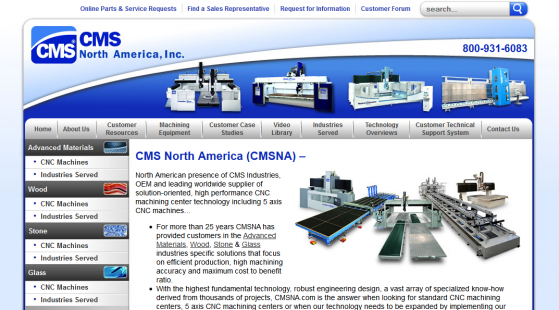In the months since we released our Internal Link Juice Tool, we’ve been using it ourselves to help clients improve the internal link structure of sites and as a result improve search engine rankings.
Reducing the number of navigation links allows more benefit to flow from each link on the site, and since the navigation links appear on every page of the site, changes to the navigation link structure is multiplied greatly, increasing the link juice flowing from every single page on the site to the navigational items.
Case Study: CMS North America
CMS North America is a manufacturer of 5 axis CNC machines with an established website with a Google toolbar PageRank of 3 and around 170 indexed pages. At the beginning of February we took a close look at the site’s internal linking structure, running it through the Internal Link Juice Tool. We saw that the site had 168 links on the home page, substantially more than the best practice guideline of no more than 100.

Many of these links were the important category pages (different kinds of machining equipment) and contact pages. But there were also large numbers of second priority links included in the global navigation through drop-downs and flyouts. Be removing these second priority pages from the global navigation we could increase the amount of PageRank that flowed through the remaining links, improving the ability of those pages to rank.
Our new navigation plan made the following changes:
- Examined every important keyword for the site and made sure the pages targeting those keywords were still included in the global navigation. These were all category level pages that users would expect to find in the global navigation.
- Shut off entirely about half of the drop-downs and flyouts on the site. As an example the About Us link had a drop-down menu that linked to a company profile, history & achievements, locations, news, tradeshows, and resources pages. We did not need links to every one of those pages from the global navigation — instead we made sure they were linked to from the About Us page and shut off the drop-down, eliminating 7 links. Similarly drop-downs were shut off for Case Studies and Industries Served and others.
- In the course of eliminating excess drop-downs and flyouts it was sometimes necessary to create new landing pages. For some product sub-categories a pass-through flyout with no landing page led to multiple individual products. We created a landing page for the pass-through and shut off the flyouts to the products. Those products are now available from the sub-category landing page.
- Some links that had no SEO importance needed to be kept for usability reasons: the Contact Us and Technical Support links, for example, remain prominent in the global navigation. Usability is always the first concern in navigation overhauls, even at the expense of SEO.
In the end the new navigation structure removed 70 links from the global navigation, reducing the total to under 100 links per page. This has the effect of allowing every page of the site to pass over 70% more PageRank through to the pages still linked in the global navigation.
Results After 6 Weeks
Within six weeks most of the site had been re-crawled by Google and indeed we saw many ranking improvements as a direct result of the navigation change. CMS North America is tracking their 21 most important keyword phrases, including several high-competition 2-word phrases, and we observed the following results:
- 18 of the 21 keyword phrases increased in rankings (two keywords were already rank 1, so only one keyword failed to improve in ranking)
- Several keywords that were not ranking in the top 100 surged up, in one case moving to ranking 13
- Keywords that were already ranking on page 1 improved an average of 1.8 rankings
- Keyword that were already ranking on page 2 improved an average of 3.7 rankings
- The lower a keyword was ranking, and the fewer external links to the landing page, the more the ranking improved, including improvements of 60 and 87 positions for keywords not in the top 100.
- Organic traffic to the site has already improved, in the form of improved quality traffic from the targeted keywords and variations thereof.
Many of these keyword phrases had been stable for long periods, including a year or more for several, before the internal navigation change improved their ranking.
PageRank & Internal Links
While Google has not updated their toolbar PageRank since the navigation restructure, it is unlikely that CMS North America will see the toolbar PageRank of internal pages change, unless those pages were already near a cusp. However, it’s important to remember that the real PageRank Google uses is far more nuanced than the toolbar version, and with the logarithmic nature of PageRank an increase from 3.4 to 3.8 brings a larger ranking benefit than an increase from 2 to 3.
The benefit of reducing the number of links within a site’s global navigation is directly related to the number of links being reduced, and the amount of external links pointing to the site. Reducing the number of links by just a handful or a small percentage is unlikely to have much noticeable ranking effect. Similarly a site without substantial external links won’t have much PageRank to pass internally, and so even doubling that amount won’t have a substantial impact on rankings.
However as we see in this case study, a site with a PageRank 3 homepage and many PR 2 internal pages can see a very substantial rankings benefit from significantly reducing the global navigation links.






